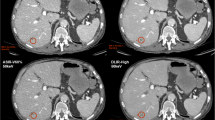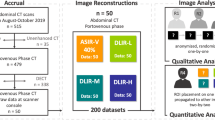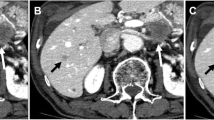Abstract
Objectives
To evaluate image quality, diagnostic acceptability, and lesion conspicuity in abdominal dual-energy CT (DECT) using deep learning image reconstruction (DLIR) compared to those using adaptive statistical iterative reconstruction-V (Asir-V) at 50% blending (AV-50), and to identify potential factors impacting lesion conspicuity.
Methods
The portal-venous phase scans in abdominal DECT of 47 participants with 84 lesions were prospectively included. The raw data were reconstructed to virtual monoenergetic image (VMI) at 50 keV using filtered back-projection (FBP), AV-50, and DLIR at low (DLIR-L), medium (DLIR-M), and high strength (DLIR-H). A noise power spectrum (NPS) was generated. CT number and standard deviation values of eight anatomical sites were measured. Signal-to-noise (SNR), and contrast-to-noise ratio (CNR) values were calculated. Five radiologists assessed image quality in terms of image contrast, image noise, image sharpness, artificial sensation, and diagnostic acceptability, and evaluated the lesion conspicuity.
Results
DLIR further reduced image noise (p < 0.001) compared to AV-50 while better preserved the average NPS frequency (p < 0.001). DLIR maintained CT number values (p > 0.99) and improved SNR and CNR values compared to AV-50 (p < 0.001). DLIR-H and DLIR-M showed higher ratings in all image quality analyses than AV-50 (p < 0.001). DLIR-H provided significantly better lesion conspicuity than AV-50 and DLIR-M regardless of lesion size, relative CT attenuation to surrounding tissue, or clinical purpose (p < 0.05).
Conclusions
DLIR-H could be safely recommended for routine low-keV VMI reconstruction in daily contrast-enhanced abdominal DECT to improve image quality, diagnostic acceptability, and lesion conspicuity.
Key Points
• DLIR is superior to AV-50 in noise reduction, with less shifts of the average spatial frequency of NPS towards low frequency, and larger improvements of NPS noise, noise peak, SNR, and CNR values.
• DLIR-M and DLIR-H generate better image quality in terms of image contrast, noise, sharpness, artificial sensation, and diagnostic acceptability than AV-50, while DLIR-H provides better lesion conspicuity than AV-50 and DLIR-M.
• DLIR-H could be safely recommended as a new standard for routine low-keV VMI reconstruction in contrast-enhanced abdominal DECT to provide better lesion conspicuity and better image quality than the standard AV-50.






Similar content being viewed by others
Abbreviations
- Asir-V:
-
Adaptive statistical iterative reconstruction-V
- CNR:
-
Contrast-to-noise ratio
- DECT:
-
Dual-energy computed tomography
- DLIR:
-
Deep learning image reconstruction
- faverage :
-
Average spatial frequency of noise power spectrum
- FBP:
-
Filtered back-projection
- fpeak :
-
Peak spatial frequency of noise power spectrum
- HU:
-
Hounsfield unit
- keV:
-
Kiloelectron volt
- NPS:
-
Noise power spectrum
- ROI:
-
Region of interest
- SD:
-
Standard deviation
- SNR:
-
Signal-to-noise ratio
- VMI:
-
Virtual monoenergetic images
References
Albrecht MH, Vogl TJ, Martin SS et al (2019) Review of clinical applications for virtual monoenergetic dual-energy CT. Radiology 293(2):260–271. https://doi.org/10.1148/radiol.2019182297
D’Angelo T, Cicero G, Mazziotti S et al (2019) Dual energy computed tomography virtual monoenergetic imaging: technique and clinical applications. Br J Radiol 92(1098):20180546. https://doi.org/10.1259/bjr.20180546
Leng S, Yu L, Fletcher JG, McCollough CH (2015) Maximizing iodine contrast-to-noise ratios in abdominal CT imaging through use of energy domain noise reduction and virtual monoenergetic dual-energy CT. Radiology 276:562–570. https://doi.org/10.1148/radiol.2015140857
Albrecht MH, Trommer J, Wichmann JL et al (2016) Comprehensive comparison of virtual monoenergetic and linearly blended reconstruction techniques in third-generation dual-source dual-energy computed tomography angiography of the thorax and abdomen. Invest Radiol 51:582–590. https://doi.org/10.1097/RLI.0000000000000272
Greffier J, Frandon J, Hamard A et al (2020) Impact of iterative reconstructions on image quality and detectability of focal liver lesions in low-energy monochromatic images. Phys Med 77:36–42. https://doi.org/10.1016/j.ejmp.2020.07.024
Greffier J, Viry A, Barbotteau Y et al (2022) Phantom task-based image quality assessment of three generations of rapid kV-switching dual-energy CT systems on virtual monoenergetic images. Med Phys 49(4):2233–2244. https://doi.org/10.1002/mp.15558
Masuda S, Yamada Y, Minamishima K, Owaki Y, Yamazaki A, Jinzaki M (2022) Impact of noise reduction on radiation dose reduction potential of virtual monochromatic spectral images: comparison of phantom images with conventional 120 kVp images using deep learning image reconstruction and hybrid iterative reconstruction. Eur J Radiol 149:110198. https://doi.org/10.1016/j.ejrad.2022.110198
Noda Y, Kawai N, Nagata S et al (2022) Deep learning image reconstruction algorithm for pancreatic protocol dual-energy computed tomography: image quality and quantification of iodine concentration. Eur Radiol 32(1):384–394. https://doi.org/10.1007/s00330-021-08121-3
Sato M, Ichikawa Y, Domae K et al (2022) Deep learning image reconstruction for improving image quality of contrast-enhanced dual-energy CT in abdomen. Eur Radiol 32(8):5499–5507. https://doi.org/10.1007/s00330-022-08647-0
Noda Y, Nakamura F, Kawamura T et al (2021) Deep-learning image-reconstruction algorithm for dual-energy CT angiography with reduced iodine dose: preliminary results. Clin Radiol 77(2):e138–e146. https://doi.org/10.1016/j.crad.2021.10.014
Noda Y, Kawai N, Kawamura T et al (2022) Radiation and iodine dose reduced thoraco-abdomino-pelvic dual-energy CT at 40 keV reconstructed with deep learning image reconstruction. Br J Radiol 95(1134):20211163. https://doi.org/10.1259/bjr.20211163
Fair E, Profio M, Kulkarni N et al (2022) Image quality evaluation in dual-energy CT of the chest, abdomen, and pelvis in obese patients with deep learning image reconstruction. J Comput Assist Tomogr 46(4):604–611. https://doi.org/10.1097/RCT.0000000000001316
Xu JJ, Lönn L, Budtz-Jørgensen E, Hansen KL, Ulriksen PS (2022) Quantitative and qualitative assessments of deep learning image reconstruction in low-keV virtual monoenergetic dual-energy CT. Eur Radiol 32(10):7098–7107. https://doi.org/10.1007/s00330-022-09018-5
Bie Y, Yang S, Li X, Zhao K, Zhang C, Zhong H (2022) Impact of deep learning-based image reconstruction on image quality compared with adaptive statistical iterative reconstruction-Veo in renal and adrenal computed tomography. J Xray Sci Technol 30(3):409–418. https://doi.org/10.3233/XST-211105
Samei E, Bakalyar D, Boedeker KL et al (2019) Performance evaluation of computed tomography systems: summary of AAPM task group 233. Med Phys 46(11):e735–e756. https://doi.org/10.1002/mp.13763
Brady SL, Trout AT, Somasundaram E, Anton CG, Li Y, Dillman JR (2021) Improving image quality and reducing radiation dose for pediatric CT by using deep learning reconstruction. Radiology 298(1):180–188. https://doi.org/10.1148/radiol.2020202317
Son W, Kim M, Hwang JY et al (2022) Comparison of a deep learning-based reconstruction algorithm with filtered back projection and iterative reconstruction algorithms for pediatric abdominopelvic CT. Korean J Radiol 23(7):752–762. https://doi.org/10.3348/kjr.2021.0466
Park S, Yoon JH, Joo I et al (2022) Image quality in liver CT: low-dose deep learning vs standard-dose model-based iterative reconstructions. Eur Radiol 32(5):2865–2874. https://doi.org/10.1007/s00330-021-08380-0
Park C, Choo KS, Jung Y, Jeong HS, Hwang JY, Yun MS (2021) CT iterative vs deep learning reconstruction: comparison of noise and sharpness. Eur Radiol 31(5):3156–3164. https://doi.org/10.1007/s00330-020-07358-8
Jensen CT, Gupta S, Saleh MM et al (2022) Reduced-dose deep learning reconstruction for abdominal CT of liver metastases. Radiology 303(1):90–98. https://doi.org/10.1148/radiol.211838
Mangiafico SS (2016) Summary and analysis of extension program evaluation in R, version 1.19.10. Accessed via rcompanion.org/handbook/ on Oct 2022
Koo TK, Li MY (2016) A guideline of selecting and reporting intraclass correlation coefficients for reliability research. J Chiropr Med 15(2):155–163. https://doi.org/10.1016/j.jcm.2016.02.012
Gisev N, Bell JS, Chen TF (2013) Interrater agreement and interrater reliability: key concepts, approaches, and applications. Res Social Adm Pharm 9(3):330–338. https://doi.org/10.1016/j.sapharm.2012.04.004
Serdar CC, Cihan M, Yücel D, Serdar MA (2021) Sample size, power and effect size revisited: simplified and practical approaches in pre-clinical, clinical and laboratory studies. Biochem Med (Zagreb) 31(1):010502. https://doi.org/10.11613/BM.2021.010502
van Stiphout JA, Driessen J, Koetzier LR et al (2022) The effect of deep learning reconstruction on abdominal CT densitometry and image quality: a systematic review and meta-analysis. Eur Radiol 32(5):2921–2929. https://doi.org/10.1007/s00330-021-08438-z
Chen Y, Zhong J, Wang L et al (2022) Robustness of CT radiomics features: consistency within and between single-energy CT and dual-energy CT. Eur Radiol 32(8):5480–5490. https://doi.org/10.1007/s00330-022-08628-3
Zhong J, Xia Y, Chen Y et al (2023) Deep learning image reconstruction algorithm reduces image noise while alters radiomics features in dual-energy CT in comparison with conventional iterative reconstruction algorithms: a phantom study. Eur Radiol 33(2):812–824. https://doi.org/10.1007/s00330-022-09119-1
Cao L, Liu X, Qu T et al (2023) Improving spatial resolution and diagnostic confidence with thinner slice and deep learning image reconstruction in contrast-enhanced abdominal CT. Eur Radiol 33(3):1603–1611. https://doi.org/10.1007/s00330-022-09146-y
Chen Y, Zhong J, Wang L et al (2022) Multivendor comparison of quantification accuracy of iodine concentration and attenuation measurements by dual-energy CT: a phantom study. AJR Am J Roentgenol 219(5):827–839. https://doi.org/10.2214/AJR.22.27753
Fukutomi A, Sofue K, Ueshima E et al (2023) Deep learning image reconstruction to improve accuracy of iodine quantification and image quality in dual-energy CT of the abdomen: a phantom and clinical study. Eur Radiol 33(2):1388–1399. https://doi.org/10.1007/s00330-022-09127-1
Acknowledgements
The authors would like to express their gratitude to Dr. Zhen Pan for her assistance in image quality assessment, and Dr. Shiqi Mao for his advice on data visualization.
Funding
This study has received funding from the National Natural Science Foundation of China (82271934, 82101986), the Yangfan Project of Science and Technology Commission of Shanghai Municipality (22YF1442400, 20YF1427200), Shanghai Science and Technology Commission Science and Technology Innovation Action Clinical Innovation Field (18411953000), Medicine and Engineering Combination Project of Shanghai Jiao Tong University (YG2019ZDB09, YG2021QN08), Research Fund of Tongren Hospital, Shanghai Jiao Tong University School of Medicine (TRKYRC-XX202204, TRGG202101, TRYJ2021JC06, 2020TRYJ(LB)06, 2020TRYJ(JC)07), and Guangci Innovative Technology Launch Plan of Ruijin Hospital, Shanghai Jiao Tong University School of Medicine (2022-13).
Author information
Authors and Affiliations
Corresponding authors
Ethics declarations
Guarantor
The scientific guarantor of this publication is Prof. Huan Zhang from the Department of Radiology, Ruijin Hospital, Shanghai Jiao Tong University School of Medicine.
Conflict of interest
Dr. Jingyu Zhong acknowledges his position as a member of the Musculoskeletal section of the Scientific Editorial Board of European Radiology. Mr. Wei Lu and Dr. Jianying Li are employees of GE Healthcare. However, they neither had access nor control over the data acquisition and analysis. All other authors of this manuscript declare no relationships with any companies, whose products or services may be related to the subject matter of the article.
Statistics and biometry
No complex statistical methods were necessary for this paper.
Informed consent
Written informed consent from all participants was received.
Ethical approval
Institutional Review Board approval was obtained.
Methodology
• prospective
• observational study
• performed at one institution
Additional information
Publisher's note
Springer Nature remains neutral with regard to jurisdictional claims in published maps and institutional affiliations.
Huan Zhang, Weiwu Yao, and Lianjun Du are co-corresponding authors.
Supplementary Information
Below is the link to the electronic supplementary material.
Rights and permissions
Springer Nature or its licensor (e.g. a society or other partner) holds exclusive rights to this article under a publishing agreement with the author(s) or other rightsholder(s); author self-archiving of the accepted manuscript version of this article is solely governed by the terms of such publishing agreement and applicable law.
About this article
Cite this article
Zhong, J., Wang, L., Shen, H. et al. Improving lesion conspicuity in abdominal dual-energy CT with deep learning image reconstruction: a prospective study with five readers. Eur Radiol 33, 5331–5343 (2023). https://doi.org/10.1007/s00330-023-09556-6
Received:
Revised:
Accepted:
Published:
Issue Date:
DOI: https://doi.org/10.1007/s00330-023-09556-6




